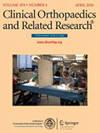Frailty Is Associated With Increased 30-day Readmissions and Costs After Total Shoulder Arthroplasty.
IF 4.2
2区 医学
Q1 ORTHOPEDICS
引用次数: 0
Abstract
BACKGROUND Frailty has been associated with a greater risk of complications and higher treatment costs for various medical conditions and surgical procedures. The Modified Frailty Index, which analyzes five or six medical comorbidities, helps grade the severity of a patient's frailty. Patients with frailty, as recognized by this index, are more likely to face adverse medical and surgical events after total shoulder arthroplasty (TSA). However, these modified indices often do not consider less common medical conditions that contribute to frailty. As such, we believe that patients may be more readily misdiagnosed as not having frailty. A more comprehensive frailty score that more accurately recognizes frailty in a wider patient population is necessary. QUESTION/PURPOSES After analyzing for any possible differences due to confounding variables such as age, gender, socioeconomic variables, and insurance provider, we asked: (1) Was frailty, defined as a score of ≥ 5 on the Hospital Frailty Risk Score (HFRS), associated with a higher risk of reoperation or readmission within 30 days of primary TSA? (2) Was frailty associated with an increased risk of major medical or surgical complications after TSA? (3) Was frailty associated with higher hospital costs (assessed by insurance charge-to-cost ratio per admission) and length of stay for patients after TSA? METHODS This study examined the Nationwide Readmissions Database, which includes patients from 28 states, representing 60% of all US residents and 60% of all US hospitalizations. We identified adult patients who were discharged after both anatomic and reverse TSA for primary osteoarthritis between January and November of 2017 to 2019 (patients who underwent TSA in December of each year were excluded). The HFRS was calculated for each patient based on 109 differently weighted ICD-10 Clinical Modification codes as validated in previous studies. Patients with an HFRS of ≥ 5 were considered as having frailty. Of the 107,774 patients who underwent TSA and were recorded in this database, 15% (16,210) were classified as patients with frailty. Patients over age 65 years comprised a larger portion of patients with frailty than patients without frailty (81% [13,130 of 16,210] of patients with frailty versus 74% [67,757 of 91,564] of patients without frailty; p < 0.01). Women comprised a larger portion of patients with frailty than patients without frailty (62% [10,050 of 16,210] women with frailty versus 53% [48,528 of 91,564] women without frailty; p < 0.01). Patients paying with Medicare comprised a larger portion of patients with frailty than patients without frailty (80% [12,968 of 16,210] Medicare payers with frailty versus 72% [65,926 of 91,564] Medicare payers without frailty; p < 0.01). We used the Student t-test to compare demographics and complication risk. After analysis of these confounders and controlling for them, we used multivariate logistic regression to analyze 30-day readmissions and negative binomial regression to analyze length of stay and hospital costs (as estimated by insurance charge-to-cost ratios per patient admission). Length of stay was expressed as an incidence rate ratio (IRR) because it was recorded and analyzed as a continuous variable. The Student t-test was used to compare demographics and risk of major surgical and medical complications of similar severity. RESULTS After controlling for confounding variables such as age, gender, socioeconomic status, and insurance provider, we found that frailty was associated with increased odds of reoperation within 30 days (OR 1.61 [95% CI 1.22 to 2.09]; p < 0.001) and increased 30-day readmissions (OR 1.79 [95% CI 1.63 to 1.97]; p < 0.001). We also found that frailty was associated with higher 30-day major surgical complication risk (0.4% [70 of 16,210] versus 0.3% [266 of 91,564]; p < 0.01) and 30-day major medical complication risk (2.6% [421 of 16,210] versus 1.1% [1007 of 91,564]; p < 0.01). We also found that frailty was associated with greater hospitalization costs (IRR 1.09 [95% CI 1.09 to 1.10]; p < 0.001) and longer lengths of hospital stay (IRR 1.46 [95% CI 1.44 to 1.47]; p < 0.001). CONCLUSION Frailty, as measured by the HFRS, is associated with increased postoperative events and estimated hospitalizations costs after TSA. The HFRS is derived from routinely collected administrative data and could help clinicians quickly identify patients at risk of complications without increased cost. Once patients with frailty are identified, clinicians may be able to provide additional counseling regarding patients' increased risk for postoperative complications and costs. An automatically calculated, robust scoring tool such as the HFRS can also aid clinicians in operative decision-making, as patients with severe frailty may be advised against undergoing TSA if the procedure is not absolutely necessary. LEVEL OF EVIDENCE Level III, therapeutic study.体弱与全肩关节置换术后 30 天再入院率和费用增加有关。
背景:身体虚弱与更大的并发症风险和更高的各种医疗条件和外科手术的治疗费用有关。修改后的虚弱指数(Modified孱弱指数)分析了五到六种医疗合并症,有助于对病人虚弱的严重程度进行分级。虚弱的患者,正如该指数所识别的,更有可能在全肩关节置换术(TSA)后面临不良的医疗和手术事件。然而,这些修改后的指数往往没有考虑到导致虚弱的不太常见的医疗条件。因此,我们认为患者可能更容易被误诊为没有虚弱。更全面的虚弱评分,更准确地识别更广泛的患者群体的虚弱是必要的。问题/目的在分析了由年龄、性别、社会经济变量和保险提供商等混杂变量引起的任何可能的差异后,我们问道:(1)虚弱(定义为医院虚弱风险评分(HFRS)得分≥5分)是否与初次TSA后30天内再手术或再入院的高风险相关?(2)体弱多病是否与TSA后主要内科或外科并发症的风险增加有关?(3)体弱多病是否与TSA后患者较高的住院费用(以每次入院的保险费用与费用比率评估)和住院时间有关?方法本研究检查了全国再入院数据库,其中包括来自28个州的患者,占美国所有居民的60%和美国所有住院病例的60%。我们确定了2017年1月至11月至2019年期间因原发性骨关节炎接受解剖和反向TSA后出院的成年患者(每年12月接受TSA的患者除外)。根据109个不同权重的ICD-10临床修改代码计算每位患者的HFRS,这些代码在以前的研究中得到验证。HFRS≥5的患者被认为是虚弱的。在107,774例接受TSA并记录在该数据库中的患者中,15%(16,210)被归类为虚弱患者。65岁以上患者中虚弱患者的比例大于无虚弱患者(81%[16,210例中有13,130例]的虚弱患者与74%[91,564例中有67,757例]的无虚弱患者;P < 0.01)。女性虚弱患者的比例大于无虚弱患者(62%[10,050 / 16,210])和53%[48,528 / 91,564]无虚弱女性;P < 0.01)。使用医疗保险支付费用的患者中,体弱多病患者的比例高于无体弱多病患者(80%[16,210人中12,968人]有体弱多病的医疗保险支付者与72%[91,564人中65,926人]无体弱多病的医疗保险支付者;P < 0.01)。我们使用学生t检验来比较人口统计学和并发症风险。在对这些混杂因素进行分析和控制后,我们使用多元逻辑回归分析30天的再入院情况,并使用负二项回归分析住院时间和住院费用(根据每位患者入院的保险收费与费用比率估计)。住院时间表示为发病率比(IRR),因为它是作为一个连续变量记录和分析的。学生t检验用于比较人口统计学特征和严重程度相似的主要手术和医疗并发症的风险。结果在控制了年龄、性别、社会经济地位和保险提供者等混杂变量后,我们发现虚弱与30天内再手术的几率增加相关(OR 1.61 [95% CI 1.22至2.09];p < 0.001)和30天再入院率增加(OR 1.79 [95% CI 1.63至1.97];P < 0.001)。我们还发现,虚弱与较高的30天主要手术并发症风险相关(0.4%[70 / 16,210]对0.3% [266 / 91,564];P < 0.01)和30天主要并发症风险(2.6%[421 / 16,210]对1.1% [1007 / 91,564];P < 0.01)。我们还发现虚弱与更高的住院费用相关(IRR 1.09 [95% CI 1.09至1.10];p < 0.001)和更长的住院时间(IRR 1.46 [95% CI 1.44至1.47];P < 0.001)。结论:HFRS测量的虚弱与TSA术后事件增加和估计住院费用相关。HFRS来自常规收集的管理数据,可以帮助临床医生在不增加费用的情况下快速识别有并发症风险的患者。一旦确定了虚弱的患者,临床医生可能能够就患者术后并发症和费用增加的风险提供额外的咨询。像HFRS这样的自动计算、强大的评分工具也可以帮助临床医生做出手术决策,因为如果手术不是绝对必要的,可能会建议严重虚弱的患者不要接受TSA。证据等级:III级,治疗性研究。
本文章由计算机程序翻译,如有差异,请以英文原文为准。
求助全文
约1分钟内获得全文
求助全文
来源期刊
CiteScore
7.00
自引率
11.90%
发文量
722
审稿时长
2.5 months
期刊介绍:
Clinical Orthopaedics and Related Research® is a leading peer-reviewed journal devoted to the dissemination of new and important orthopaedic knowledge.
CORR® brings readers the latest clinical and basic research, along with columns, commentaries, and interviews with authors.

 求助内容:
求助内容: 应助结果提醒方式:
应助结果提醒方式:


